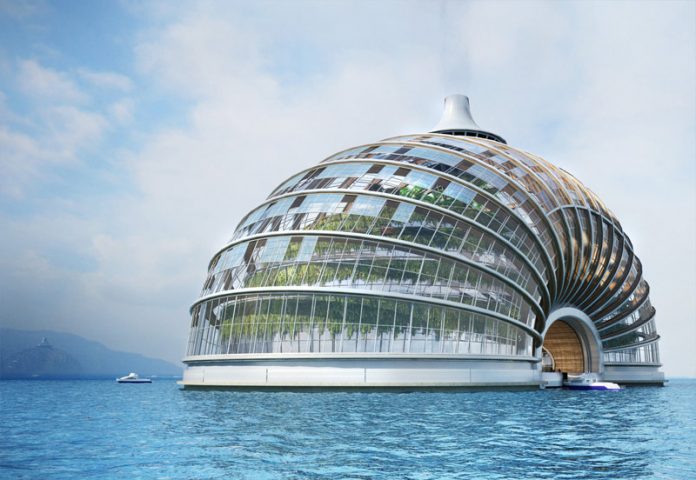The Ark concept, which Remistudio designed in connection with the International Union of Architects’ program “Architecture for Disaster Relief,” can be built in various climates and in seismically dangerous regions because its basement is a shell structure, devoid of ledges or angles. A load-bearing system of arches and cables allows weight redistribution along the entire corpus in case of an earthquake. The building’s clever design enables an optimal relationship between its volume and its outer surface, significantly saving materials and providing energy efficiency. Itsprefabricated frame also allows for fast construction.
The Ark constitutes a single energysystem. Its shape is convenient for installing photovoltaic cells at an optimal angle toward the sun. The cupola, in the upper part, collects warm air which is gathered in seasonal heat accumulators to provide an uninterrupted energy supply for the whole complex independently from outer environmental conditions. The heat from the surrounding environment — the outer air, water or ground — is also used.
Planting greenery is the next step in creating a bioclimatic building and the Ark is filled with it. The tall, illuminated inside space creates well-lit places to grow plants at any time of day. Enough daylight penetrates through the transparent roof to illuminate the inner rooms as well. The tiered balconies serve as social and recreational areas and the Ark has an open layout that can easily be adapted to different functions over time.
The Ark’s structural solidity is provided by compression of timber arches and tension of steel cables. The framework is covered by a special foil made of ethyltetrafluoroethylene, or ETFE. It is a strong, highly transparent foil that is self-cleaning, recyclable, and more durable, cost-efficient and lighter than glass. The foil itself is affixed to the framework by special metal profiles, which serve as solar collectors for heating water and as gutters for collecting rainwater from the roof.
INHABITAT INTERVIEW: Water Architect Koen Olthuis on Floating Buildings & Hydro-Cities
You’ve made quite a name for yourself as a designer of floating buildings. What attracts you to floating architecture? What got you started in this space?
I grew up in theNetherlands, half of which is situated below sea level. Thirty percent of its surface is covered with lakes, rivers and canals. What got me started was my refusal to believe that water is a border for urban components – I wanted to go beyond the waterfront. But what attracts me the most about floating architecture is the enormous flexibility water offers us, and the virtually unexplored limitless possibilities water brings to metropolises worldwide. Planning for urban change using water will help us cope with the yet unforeseen effects of climate change and urbanization.
What is your favorite floating building project that you’ve worked on and why?
I would say the floating harbor for Dubai. This project ticks all the boxes in terms of what’s important in communicating the potential of floating developments, helping to make them a reality worldwide:
– The size. Shaped as a triangle with three sides of some 700 meters each, the buildings dimensions are huge.
– Change of perception. It’s one of those buildings that makes you realize how solutions can sometimes be found by thinking differently. A harbor itself can be floating too.
– A different kind of architecture. On the water there is more space, so we can project buildings that do not have to fit within the urban limitations of size and structure.
– The sustainable possibilities. The building shows how building on the water can take advantage of new technologies in creating sustainable projects. This building for example will use water cooling and generate its own energy by means of solar cells.
– Technical innovation. The building will also function as a breakwater for the inner harbor which is used for the smaller transit boats. The structure itself thus provides protection for wind and waves.
– Showcase of proven technology. The building uses a combination of existing offshore technologies like huge oil tankers, oil rigs, ocean liners, and so on; each of these elements show us how solutions can be found if we look beyond the confines of our own architectural profession.
You’re a proponent of the Hydro-City, and this is not just because you’re from a country that sits below sea level. What are the advantages of floating buildings? Of a floating city? What are the challenges and the limitations?
Floating urban components will be a new tool in the ongoing search to make our greatest cities worldwide more sustainable and livable. I strongly believe that we will enter an era of consumption urbanism in which floating urban components will help us to react quickly and sustainably to the growing mix of changes. Cities will start using City Apps, which are a set of combined urban components that can be ordered via City Apps Stores. In these stores a city council or government can lease a function that can offer instant relief to a occurring problem. These city apps are already built and in stock. When someone leases a City App it can be transported in smaller urban components to cities worldwide over water. This will create a new market and flexibility. The life span of the urban components themselves are very long, so that if they are not needed any more they can be sent back to the lease company or been sold to another city. City Apps are not so different from smart phone apps – they upgrade the functionality of the existing hardware, which in this case is a city’s structure.
Floating architecture might be a hard concept to understand for people who aren’t used to this idea – how do you help potential clients and stakeholders visualize your ideas?
The biggest challenge we face is to convince our clients and stakeholders, and this comes through changing their perception. With floating developments people tend to think about boats and small structures. With our visualization tools, as well as our animations, we can offer our clients a view into their future situation. These computer tools make it possible to show the floating building in all kinds of scenarios, whether they are the effects of climate change through rising water levels, or simply the local site situation.
A lot of your projects have amazing, provocative renderings. How have digital 3D modeling tools helped you explore and shape your ideas, especially as it comes to building on water?
In our business there are three important catalyzing facts that have created momentum for our floating ideas. First there is this focus on climate change. In particular the work of Al Gore and president Nasheed of the Maldives has helped to raise awareness, as they have both had the courage to tell a difficult message as well as to open the way for innovation. The second catalyst is urbanization and its request for urban space – the need for more density in our cities will only continue to grow.
Thirdly, there are the 3D tools available today. When I studied architecture in the early nineties, 3D tools were not as common as they are now. I had to explain my somewhat strange ideas with drawings and sketches made by hand. It was always necessary to convince my professors with a lot of verbal explanations in addition to the visual material. Now we do not only present our ideas with 3D renderings, but we also use those models to study and design our projects. All of our projects are constantly developed and evaluated through research in a series of digital 3D models. This way of working also allows serendipity to have influence on our work. Working with the computer sometimes generates possibilities and shapes that we didn’t deliberately think off.
How does floating architecture tie into sustainable design?
The first and most important goal in all of our plans is to design scarless developments. This means that both during as well as after the lifespan of the functions, the building leaves neither a physical footprint nor carbon footprint. Compared with building on land, water provides several opportunities for a more sustainable design approach. For example, one can think of water cooling and heating. These developments can use sea wind for cooling, floating solar fields for the local production of energy, and there is also potential for re-using a building at other locations and organizing the building process more efficiently by centralizing construction. ‘Sustainaquality’ is the search for new ways to increase sustainable developments. Sustainaquality brings together sustainability- aqua and quality.
Living on water is an idea that is finding itself on the radars of more and more people. What do you see as the catalyst for this movement going from a novel idea to widespread reality?
The predicted growth of the world’s population to about 10 billion people by the year 2100 – this is the strongest catalyst for this movement. Mega-cities are desperately in search of space, and if we want to protect our planet while creating new density at the same time, we have to use the existing water in and around our cities. The key to a sustainable future for humanity can be found in a healthy balance between the use of land and water for the production of food, energy, clean water and shelter. Going beyond the waterfront is an efficient and exciting way to bring extra flexibility to our planet.
































